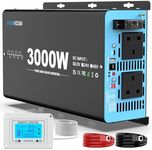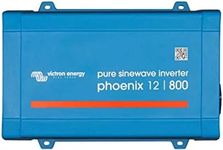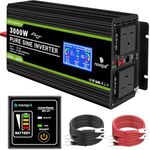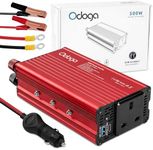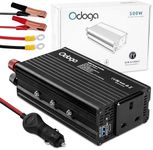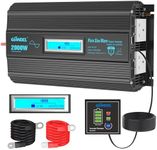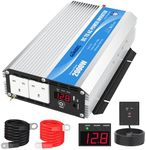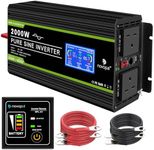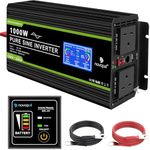Buying Guide for the Best Power Inverters
Choosing the right power inverter can be a bit daunting, but with the right knowledge, you can find the perfect fit for your needs. Power inverters convert DC (direct current) power from sources like car batteries or solar panels into AC (alternating current) power, which is what most household appliances use. Understanding the key specifications will help you make an informed decision and ensure that the inverter you choose meets your power requirements and usage scenarios.WattageWattage indicates the total power output that the inverter can handle. This is crucial because it determines what and how many devices you can run simultaneously. Inverters come in various wattage ratings, typically ranging from 150 watts to several thousand watts. For small devices like laptops and phone chargers, a lower wattage inverter (150-300 watts) is sufficient. For larger appliances like microwaves or power tools, you will need a higher wattage inverter (1000 watts or more). Assess the total wattage of the devices you plan to use and choose an inverter that can handle that load.
Continuous vs. Peak PowerContinuous power is the amount of power the inverter can supply on a regular basis, while peak power is the maximum power it can provide for a short burst, usually to start a device with a high initial power draw. This is important because some devices, like refrigerators or pumps, require a higher power surge to start up. When selecting an inverter, ensure that its continuous power rating meets your regular usage needs and that its peak power rating can handle the startup requirements of your devices.
Waveform TypeInverters produce different types of waveforms: pure sine wave, modified sine wave, and square wave. Pure sine wave inverters produce power that is identical to or better than the power supplied by the grid, making them suitable for sensitive electronics and medical equipment. Modified sine wave inverters are less expensive and work well for most household appliances, but may not be suitable for sensitive devices. Square wave inverters are the least expensive and least efficient, typically used for simple tools and devices. Choose a pure sine wave inverter for sensitive electronics and a modified sine wave inverter for general household use.
Input VoltageInput voltage refers to the voltage required from the DC power source, commonly 12V or 24V. This is important because it needs to match the voltage of your power source, such as a car battery or solar panel system. Most car batteries provide 12V, so a 12V input inverter is suitable for automotive use. For larger solar power systems, a 24V input inverter may be more appropriate. Ensure the input voltage of the inverter matches your power source to avoid compatibility issues.
Number and Type of OutletsThe number and type of outlets on an inverter determine how many devices you can connect and what types of plugs are supported. Inverters typically come with a combination of AC outlets, USB ports, and sometimes DC outlets. Consider the types of devices you plan to use and ensure the inverter has enough outlets to accommodate them. For example, if you need to charge multiple devices simultaneously, look for an inverter with multiple AC outlets and USB ports.
EfficiencyEfficiency refers to how well the inverter converts DC power to AC power, with higher efficiency meaning less energy is wasted. This is important for maximizing the use of your power source, especially in off-grid or battery-powered situations. Inverters typically have efficiency ratings between 85% and 95%. Higher efficiency inverters are more desirable as they provide more usable power and reduce energy loss. Look for an inverter with a high efficiency rating to ensure optimal performance.
Safety FeaturesSafety features protect both the inverter and your devices from damage. Common safety features include overload protection, short circuit protection, over-temperature protection, and low voltage shutdown. These features are important to prevent damage to the inverter and connected devices, and to ensure safe operation. Choose an inverter with comprehensive safety features to protect your investment and ensure reliable performance.
